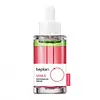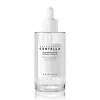What's inside
What's inside
 Key Ingredients
Key Ingredients

 Benefits
Benefits

 Concerns
Concerns

No concerns
 Ingredients Side-by-side
Ingredients Side-by-side

Water
Skin ConditioningCetyl Ethylhexanoate
EmollientDipropylene Glycol
Humectant1,2-Hexanediol
Skin ConditioningNiacinamide
Smoothing3-O-Ethyl Ascorbic Acid
Skin ConditioningSodium Chloride
MaskingSodium Citrate
BufferingDipotassium Glycyrrhizate
HumectantXanthan Gum
EmulsifyingCitrullus Lanatus Fruit Extract
Skin ConditioningPhosphatidylcholine
EmulsifyingPolyglyceryl-10 Laurate
Skin ConditioningAdenosine
Skin ConditioningGardenia Taitensis Callus Extract
AntioxidantDextrin
AbsorbentAzadirachta Indica Leaf Extract
Skin ConditioningNasturtium Officinale Extract
PerfumingNasturtium Officinale Leaf Extract
MaskingCaramel
Cosmetic ColorantActinidia Chinensis Fruit Extract
EmollientCarum Carvi Seed Oil
MaskingLac Powder
Skin ConditioningSolanum Melongena Fruit Extract
Skin ConditioningAscorbic Acid
AntioxidantOcimum Sanctum Leaf Extract
Skin ConditioningCoral Extract
Skin ConditioningCurcuma Longa Root Extract
MaskingGlutathione
Caffeine
Skin ConditioningPanthenol
Skin ConditioningAllantoin
Skin ConditioningSodium Hyaluronate
HumectantWater, Cetyl Ethylhexanoate, Dipropylene Glycol, 1,2-Hexanediol, Niacinamide, 3-O-Ethyl Ascorbic Acid, Sodium Chloride, Sodium Citrate, Dipotassium Glycyrrhizate, Xanthan Gum, Citrullus Lanatus Fruit Extract, Phosphatidylcholine, Polyglyceryl-10 Laurate, Adenosine, Gardenia Taitensis Callus Extract, Dextrin, Azadirachta Indica Leaf Extract, Nasturtium Officinale Extract, Nasturtium Officinale Leaf Extract, Caramel, Actinidia Chinensis Fruit Extract, Carum Carvi Seed Oil, Lac Powder, Solanum Melongena Fruit Extract, Ascorbic Acid, Ocimum Sanctum Leaf Extract, Coral Extract, Curcuma Longa Root Extract, Glutathione, Caffeine, Panthenol, Allantoin, Sodium Hyaluronate
Water
Skin ConditioningButylene Glycol
HumectantNiacinamide
SmoothingGlycerin
HumectantTranexamic Acid
Astringent1,2-Hexanediol
Skin ConditioningBetaine
HumectantCentella Asiatica Extract
CleansingZea Mays Starch
AbsorbentXanthan Gum
EmulsifyingMicrocrystalline Cellulose
AbsorbentMannitol
HumectantPanthenol
Skin ConditioningPentylene Glycol
Skin ConditioningEthylhexylglycerin
Skin ConditioningHydroxyethylcellulose
Emulsion StabilisingMadecassoside
AntioxidantAcrylates/C10-30 Alkyl Acrylate Crosspolymer
Emulsion StabilisingArginine
MaskingHydrogenated Lecithin
EmulsifyingXylitylglucoside
HumectantAnhydroxylitol
HumectantXylitol
HumectantGlucose
Humectant3-O-Ethyl Ascorbic Acid
Skin ConditioningLactobacillus Ferment
Skin ConditioningWater, Butylene Glycol, Niacinamide, Glycerin, Tranexamic Acid, 1,2-Hexanediol, Betaine, Centella Asiatica Extract, Zea Mays Starch, Xanthan Gum, Microcrystalline Cellulose, Mannitol, Panthenol, Pentylene Glycol, Ethylhexylglycerin, Hydroxyethylcellulose, Madecassoside, Acrylates/C10-30 Alkyl Acrylate Crosspolymer, Arginine, Hydrogenated Lecithin, Xylitylglucoside, Anhydroxylitol, Xylitol, Glucose, 3-O-Ethyl Ascorbic Acid, Lactobacillus Ferment
 Reviews
Reviews

Ingredients Explained
These ingredients are found in both products.
Ingredients higher up in an ingredient list are typically present in a larger amount.
1,2-Hexanediol is a synthetic liquid and another multi-functional powerhouse.
It is a:
- Humectant, drawing moisture into the skin
- Emollient, helping to soften skin
- Solvent, dispersing and stabilizing formulas
- Preservative booster, enhancing the antimicrobial activity of other preservatives
You might know this ingredient as Ethyl Ascorbic Acid, a more stable version of ascorbic acid.
Like other types of vitamin C, this ingredient has many benefits including reducing wrinkles, skin soothing, dark spot fading, and fighting against free radicals.
3-O-Ethyl Ascorbic Acid interferes with the process of skin darkening, helping to reduce hyperpigmentation. It also encourages the skin to produce more collagen.
Once applied, 3-O-Ethyl Ascorbic Acid is converted to Vitamin C deeper in the skin's layers. This process is slow but makes this ingredient more tolerable for skin.
The optimum pH range for this ingredient is 4 - 5.5
Learn more about 3-O-Ethyl Ascorbic AcidNiacinamide is a multitasking form of vitamin B3 that strengthens the skin barrier, reduces pores and dark spots, regulates oil, and improves signs of aging.
And the best part? It's gentle and well-tolerated by most skin types, including sensitive and reactive skin.
You might have heard of "niacin flush", or the reddening of skin that causes itchiness. Niacinamide has not been found to cause this.
In very rare cases, some individuals may not be able to tolerate niacinamide at all or experience an allergic reaction to it.
If you are experiencing flaking, irritation, and dryness with this ingredient, be sure to double check all your products as this ingredient can be found in all categories of skincare.
When incorporating niacinamide into your routine, look out for concentration amounts. Typically, 5% niacinamide provides benefits such as fading dark spots. However, if you have sensitive skin, it is better to begin with a smaller concentration.
When you apply niacinamide to your skin, your body converts it into nicotinamide adenine dinucleotide (NAD). NAD is an essential coenzyme that is already found in your cells as "fuel" and powers countless biological processes.
In your skin, NAD helps repair cell damage, produce new healthy cells, support collagen production, strengthen the skin barrier, and fight environmental stressors (like UV and pollution).
Our natural NAD levels start to decline with age, leading to slower skin repair, visible aging, and a weaker skin barrier. By providing your skin niacinamide, you're recharging your skin's NAD levels. This leads to stronger, healthier, and younger looking skin.
Another name for vitamin B3 is nicotinamide. This vitamin is water-soluble and our bodies don't store it. We obtain Vitamin B3 from either food or skincare. Meat, fish, wheat, yeast, and leafy greens contain vitamin B3.
The type of niacinamide used in skincare is synthetically created.
Learn more about NiacinamidePanthenol is a common ingredient that helps hydrate and soothe the skin. It is found naturally in our skin and hair.
There are two forms of panthenol: D and L.
D-panthenol is also known as dexpanthenol. Most cosmetics use dexpanthenol or a mixture of D and L-panthenol.
Panthenol is famous due to its ability to go deeper into the skin's layers. Using this ingredient has numerous pros (and no cons):
Like hyaluronic acid, panthenol is a humectant. Humectants are able to bind and hold large amounts of water to keep skin hydrated.
This ingredient works well for wound healing. It works by increasing tissue in the wound and helps close open wounds.
Once oxidized, panthenol converts to pantothenic acid. Panthothenic acid is found in all living cells.
This ingredient is also referred to as pro-vitamin B5.
Learn more about PanthenolWater. It's the most common cosmetic ingredient of all. You'll usually see it at the top of ingredient lists, meaning that it makes up the largest part of the product.
So why is it so popular? Water most often acts as a solvent - this means that it helps dissolve other ingredients into the formulation.
You'll also recognize water as that liquid we all need to stay alive. If you see this, drink a glass of water. Stay hydrated!
Learn more about WaterXanthan gum is used as a stabilizer and thickener within cosmetic products. It helps give products a sticky, thick feeling - preventing them from being too runny.
On the technical side of things, xanthan gum is a polysaccharide - a combination consisting of multiple sugar molecules bonded together.
Xanthan gum is a pretty common and great ingredient. It is a natural, non-toxic, non-irritating ingredient that is also commonly used in food products.
Learn more about Xanthan Gum